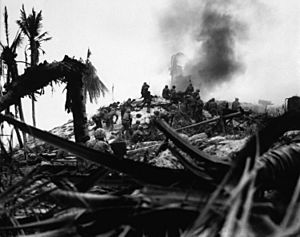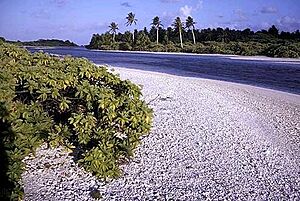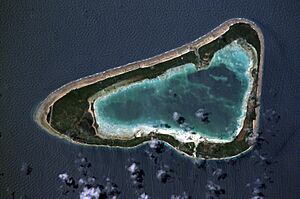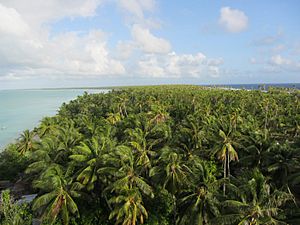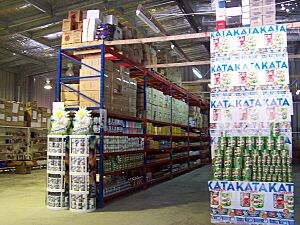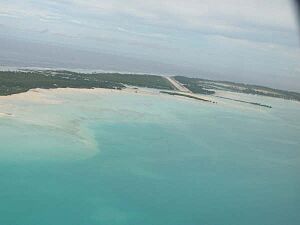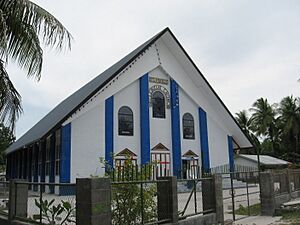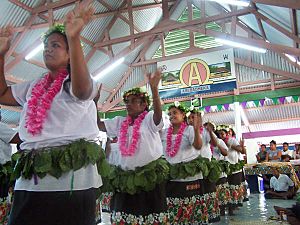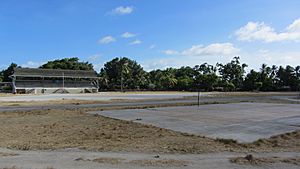Kiribati facts for kids
Quick facts for kids
Republic of Kiribati
Ribaberiki Kiribati (Gilbertese)
|
|
|---|---|
|
|
|
|
Motto: Te Mauri, te Raoi ao te Tabomoa
("Health, Peace and Prosperity") |
|
|
Anthem: Kunan Kiribati
("Song of Kiribati") |
|
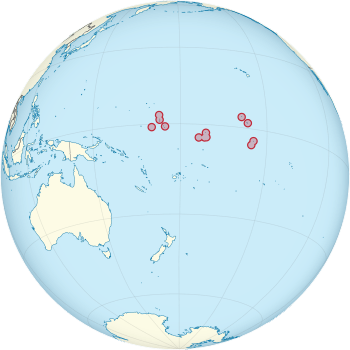 |
|
| Capital | Tarawa 1°28′N 173°2′E / 1.467°N 173.033°E |
| Largest city | South Tarawa |
| Official languages | |
| Ethnic groups
(2020 census)
|
|
| Religion
(2020 census)
|
|
| Demonym(s) | I-Kiribati |
| Government | Unitary parliamentary republic with an executive presidency |
| Taneti Maamau | |
| Teuea Toatu | |
| Legislature | House of Assembly |
| Independence from the United Kingdom | |
|
• Granted
|
12 July 1979 |
|
• Treaty of Tarawa
|
20 September 1979 |
| Area | |
|
• Total
|
811.19 km2 (313.20 sq mi) (172nd) |
| Population | |
|
• 2021 estimate
|
121,388 (192nd) |
|
• 2020 census
|
119,438 |
|
• Density
|
147.2/km2 (381.2/sq mi) |
| GDP (PPP) | 2023 estimate |
|
• Total
|
|
|
• Per capita
|
|
| GDP (nominal) | 2023 estimate |
|
• Total
|
|
|
• Per capita
|
|
| Gini (2019) | 27.8 low |
| HDI (2022) | medium · 137th |
| Currency | Australian dollar ($) (AUD) |
| Time zone | UTC+12, +13, +14 |
| Driving side | left |
| Calling code | +686 |
| ISO 3166 code | KI |
| Internet TLD | .ki |
Kiribati ( kirr-I-bass), officially the Republic of Kiribati (Gilbertese: Ribaberiki Kiribati), is an island country in the Micronesia subregion of Oceania in the central Pacific Ocean. Its permanent population is over 119,000 as of the 2020 census, with more than half living on Tarawa atoll. The state comprises 32 atolls and one remote raised coral island, Banaba. Its total land area is 811 km2 (313 sq mi) dispersed over 3,441,810 km2 (1,328,890 sq mi) of ocean.
The islands' spread straddles the equator and the 180th meridian, making Kiribati the only country in the world located simultaneously in all four hemispheres: the Northern, Southern, Western, and Eastern hemispheres. The International Date Line goes around Kiribati and swings far to the east, almost reaching 150°W. This brings Kiribati's easternmost islands, the southern Line Islands south of Hawaii, into the same day as the Gilbert Islands and places them in the most advanced time zone on Earth: UTC+14.
Kiribati gained its independence from the United Kingdom, becoming a sovereign state in 1979. The capital, South Tarawa, now the most populated area, consists of a number of islets, connected by a series of causeways. These comprise about half the area of Tarawa Atoll. Prior to its independence, the country had exported phosphate, but those mines are no longer viable. Fisheries and export of copra drive much of the economy. Kiribati is one of the least developed countries in the world and is highly dependent on international aid for its economy.
Kiribati is a member of the Pacific Community, Commonwealth of Nations, the International Monetary Fund, the World Bank, and the Organisation of African, Caribbean and Pacific States, and became a full member of the United Nations in 1999. As an island nation, the islands are vulnerable to climate change and tsunamis. Addressing climate change has been a central part of its international policy, as a member of the Alliance of Small Island States.
Contents
Etymology and pronunciation
The name is pronounced kirr-I-bass, as -ti in the Gilbertese language represents an sound. Similarly, the name of its people, the I-Kiribati, is pronounced EE-kirr-I-bass.
The name Kiribati was adopted upon the country's independence in 1979. It is the Gilbertese rendition of Gilberts, the plural of the English name of the nation's main archipelago, the Gilbert Islands. It was named îles Gilbert (French for 'Gilbert Islands') in about 1820 by Russian admiral Adam von Krusenstern and French captain Louis Duperrey, after the British captain Thomas Gilbert. Gilbert and captain John Marshall sighted some of the islands in 1788, while crossing the "outer passage" route from Port Jackson to Canton. Both von Krusenstern's and Duperrey's maps, published in 1824, were written in French.
In French, the Northern Islands were until then called îles Mulgrave and Byron Island was not part of them. In English, the archipelago, particularly the southern part, was often referred to as the Kingsmills in the 19th century, although the name Gilbert Islands was used increasingly, including in the Western Pacific Order in Council of 1877 and in the Pacific Order of 1893.
The name Gilbert, already in the name of the British protectorate since 1892, was incorporated into the name of the entire Gilbert and Ellice Islands Colony (GEIC) from 1916 and was retained after the Ellice Islands became the separate country of Tuvalu in 1976. The spelling of Gilberts in the Gilbertese language as Kiribati may be found in books in Gilbertese prepared by missionaries, but with the meaning of Gilbertese (demonym and language) (see e.g., Hawaiian Board of Missionaries, 1895). The first mention as a dictionary entry of the word Kiribati as the native name of the country was written down in 1952 by Ernest Sabatier in his comprehensive Dictionnaire gilbertin–français.
The indigenous name often suggested for the Gilbert Islands proper is Tungaru (see e.g., Ernest Sabatier, 1952–1953, or Arthur Grimble, 1989). The rendition Kiribati for Gilberts was chosen as the official name of the new independent state by the chief minister, Sir Ieremia Tabai and his cabinet, on such grounds that it was modern, and to comprehend the inclusion of outer islands (e.g., the Phoenix Group and Line Islands), which were not considered part of the Tungaru (or Gilberts) chain.
History
Early history
The area now called Kiribati has been inhabited by Austronesian peoples speaking the same Oceanic language, from north to south, including the southernmost Nui, since sometime between 3000 BCE and 1300 CE. The area was not completely isolated; later, voyagers from Samoa, Tonga, and Fiji introduced some Polynesian and Melanesian cultural aspects, respectively. Intermarriage and intense navigation between the islands tended to blur cultural differences and resulted in a significant degree of cultural homogenization. Local oral historians chiefly in the form of lore keepers suggest that the area was first inhabited by a group of seafaring people from Melanesia, who were described as being dark-skinned, frizzy-haired, and short in stature. These indigenous peoples were then visited by early Austronesian seafarers from the west, a place called Matang, orally described as being tall and fair-skinned. Eventually, both groups intermittently clashed and intermingled until they slowly became a uniform population.
Around 1300 CE, a mass departure occurred from Samoa leading to the addition of Polynesian ancestry into the mix of most Gilbertese people. These Samoans later brought strong features of Polynesian languages and culture, creating clans based on their own Samoan traditions and slowly intertwining with the indigenous clans and powers already dominant in Kiribati. Around the 15th century, starkly contrasting systems of governance arose between the northern islands, primarily under chiefly rule (uea), and the central and southern islands, primarily under the rule of their council of elders (unimwaane). Tabiteuea could be an exception as the sole island that is known as maintaining a traditional egalitarian society. The name Tabiteuea stems from the root phrase Tabu-te-Uea, meaning "chiefs are forbidden". Civil war soon became a factor, with acquisition of land being the main form of conquest. Clans and chiefs began fighting over resources, fueled by hatred and reignited blood feuds, which may have started months, years, or even decades before.
The turmoil lasted well into the European visitation and colonial era, which led to certain islands decimating their foes with the help of guns and cannon-equipped ships that Europeans provided to some I-Kiribati leaders. The typical military arms of the I-Kiribati at this time were shark tooth-embedded wooden spears, knives, and swords, and garbs of armour fashioned from dense coconut fibre. They chiefly used these instead of the gunpowder and weapons of steel available at the time, because of the strong sentimental value of the equipment handed down through generations. Ranged weapons, such as bows, slings, and javelins, were seldom used; hand-to-hand combat was a prominent skill still practised today, though seldom mentioned because of various taboos associated with it, secrecy being the primary one. Abemama's High Chief Tembinok' was the last of the dozens of expansionist chiefs of Gilbert Islands of this period, despite Abemama historically conforming to the traditional southern islands' governance of their respective unimwaane. He was immortalised in Robert Louis Stevenson's book In the South Seas, which delved into the high chief's character and method of rule during Stevenson's stay in Abemama. The 90th anniversary of his arrival in the Gilbert Islands was chosen to celebrate the independence of Kiribati on 12 July 1979.
Colonial era
Chance visits by European ships occurred in the 17th and 18th centuries, while those ships attempted circumnavigations of the world, or sought sailing routes from the south to north Pacific Ocean. A passing trade, whaling the On-The-Line grounds, and labour ships associated with the coercive labour recruitment practices, known as blackbirding. This recruitment of Kanaka workers in large numbers during the 19th century, had social, economic, political, religious and cultural consequences. More than 9,000 workers were sent abroad from 1845 to 1895, most of them not returning.
The passing trade gave rise to European, Indian, Chinese, Samoan, and other residents from the 1830s; they included beachcombers, castaways, traders, and missionaries. Dr Hiram Bingham II of the American Board of Commissioners for Foreign Missions (ABCFM) arrived on Abaiang in 1857. The Roman Catholic faith was introduced on Nonouti around 1880 by 2 Gilbert islanders, Betero and Tiroi, who had become Christians in Tahiti. Father Joseph Leray, Father Edward Bontemps and Brother Conrad Weber, Roman Catholic Missionaries of the Sacred Heart arrived on Nonouti in 1888. The protestant missionaries of the London Missionary Society (LMS) were also active in the southern Gilberts. On 15 October 1870, Rev. Samuel James Whitmee of the LMS arrived at Arorae, and later that month he visited Tamana, Onotoa and Beru. In August 1872, George Pratt of the LMS visited the islands.
In 1886, an Anglo-German agreement partitioned the "unclaimed" central Pacific, leaving Nauru in the German sphere of influence, while Ocean Island and the future GEIC wound up in the British sphere of influence. In 1892, local Gilbertese authorities (an uea, a chief from the Northern Gilbert Group, and atun te boti or head of clan) on each of the Gilbert Islands agreed to Captain Edward Davis commanding HMS Royalist of the Royal Navy declaring them part of a British protectorate, along with the nearby Ellice Islands. They were administered by a resident commissioner based first on Makin Islands (1893–95), then in Betio, Tarawa (1896–1908) and Ocean Island (1908–1942), protectorate who was under the Western Pacific High Commission (WPHC) based in Fiji. Banaba, known to Europeans as Ocean Island, was added to the protectorate in 1900, because of the phosphate rock of its soil (discovered in 1900). This discovery and the mining provided a significant amount of revenue, in the form of taxes and duties, to the WPHC.
The conduct of William Telfer Campbell, the second resident commissioner of the Gilberts and Ellice Islands of 1896 to 1908, was criticised as to his legislative, judicial and administrative management (including allegations of forced labour exacted from islanders) and became the subject of the 1909 report by Arthur Mahaffy. In 1913, an anonymous correspondent to The New Age newspaper described the maladministration of W. Telfer Campbell and challenged the impartiality of Arthur Mahaffy, because he was a former colonial official in the Gilberts. The anonymous correspondent also criticised the operations of the Pacific Phosphate Company on Ocean Island.
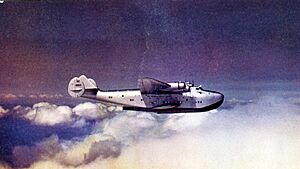
The islands became the crown colony of the Gilbert and Ellice Islands in 1916. The Northern Line Islands, including Christmas Island (Kiritimati), were added to the colony in 1919, and the Phoenix Islands were added in 1937 with the purpose of a Phoenix Islands Settlement Scheme. On 12 July 1940, Pan Am Airways' American Clipper landed at Canton Island for the first time during a flight from Honolulu to Auckland.
Sir Arthur Grimble was a cadet administrative officer based at Tarawa (1913–1919) and became Resident Commissioner of the Gilbert and Ellice Islands colony in 1926.

In 1902, the Pacific Cable Board laid the first trans-Pacific telegraph cable from Bamfield, British Columbia, to Fanning Island (Tabuaeran) in the Line Islands, and from Fiji to Fanning Island, thus completing the All Red Line, a series of telegraph lines circumnavigating the globe completely within the British Empire. The location of Fanning Island, one of the closest formations to Hawaii, led to its annexation by the British Empire in 1888. Nearby candidates including Palmyra Island were not favoured due to the lack of adequate landing sites.
The United States eventually incorporated the Northern Line Islands into its territories, and did the same with the Phoenix Islands, which lie between Gilberts and the Line Islands, including Howland, Jarvis, and Baker islands, thus causing a territorial dispute. That was eventually resolved and they finally became part of Kiribati under the Treaty of Tarawa.
After the attack on Pearl Harbor, during World War II, Butaritari and Tarawa, and others of the Northern Gilbert group, were occupied by Japan from 1941 to 1943. Betio became an airfield and supply base. The expulsion of the Japanese military in late 1943 involved one of the bloodiest battles in US Marine Corps history. Marines landed in November 1943 and the Battle of Tarawa ensued. Ocean Island, the headquarters of the colony, was bombed, evacuated and occupied by Japan in 1942 and not freed until 1945, after the massacre of all but one of the Gilbertese on the island by the Japanese forces. Funafuti hosted then the provisional headquarters of the colony from 1942 to 1946, when Tarawa returned to host the headquarters, replacing Ocean Island.
At the end of 1945, most of the remaining inhabitants of Banaba, repatriated from Kosrae, Nauru and Tarawa, were relocated to Rabi Island, a land of Fiji that the British government had acquired in 1942 for this purpose.
On 1 January 1953, the British Western Pacific High Commissioner of the colony was transferred from Fiji to the new capital of Honiara, to the British Solomon Islands, with the Gilberts' Resident Commissioner still headquartered in Tarawa.
Further military operations in the colony occurred in the late 1950s and early 1960s when Christmas Island was used by the United States and United Kingdom for nuclear weapons testing including hydrogen bombs.
Institutions of internal self-rule were established on Tarawa from about 1967. The Ellice Islands asked for separation from the rest of the colony in 1974 and granted their own internal self-rule institutions. The separation entered into force on 1 January 1976. In 1978, the Ellice Islands became the independent state of Tuvalu.
Independence
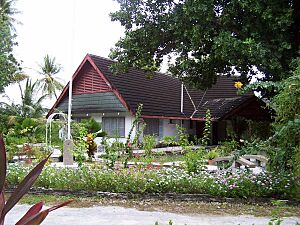
The Gilbert Islands gained independence as the Republic of Kiribati on 12 July 1979. Then, in September, the United States relinquished all claims to the sparsely inhabited Phoenix and Line Islands, in a 1979 treaty of friendship with Kiribati (ratified in 1983). Although the indigenous Gilbertese name for the Gilbert Islands proper is "Tungaru", the new state chose the name "Kiribati", the Gilbertese spelling of "Gilberts", because it was more modern and as an equivalent of the former colony to acknowledge the inclusion of Banaba, the Line Islands, and the Phoenix Islands. The last two archipelagoes were never initially occupied by Gilbertese until the British authorities, and later the Republic Government, resettled Gilbertese there under resettlement schemes. In 1982, the first elections since independence were held. A no-confidence vote provoked the 1983 new election. In the post-independence era, overcrowding has been an issue, at least in British and aid organisations' eyes. In 1988, an announcement was made that 4,700 residents of the main island group would be resettled onto less populated islands. In September 1994, Teburoro Tito from the opposition was elected president.
In 1995, Kiribati unilaterally moved the International Date Line far to the east to encompass the Line Islands group, so that the country would no longer be divided by the date line. The move, which fulfilled one of President Tito's campaign promises, was intended to allow businesses across the expansive territory to keep the same business week. This also enabled Kiribati to become the first country to see the dawn of the third millennium, an event of significance for tourism. Tito was re-elected in 1998. In 1999, Kiribati became a full member of the United Nations, 20 years after independence. In 2002, Kiribati passed a controversial law that enabled the government to shut down newspaper publishers. The legislation followed the launching of Kiribati's first successful non-government-run newspaper. President Tito was re-elected in 2003 but was removed from office in March 2003 by a no-confidence vote and replaced by a Council of State. Anote Tong of the opposition party Boutokaan Te Koaua was elected to succeed Tito in July 2003. He was re-elected in 2007 and in 2011.
In June 2008, Kiribati officials asked Australia and New Zealand to accept Kiribati citizens as permanent refugees. Kiribati is expected to be the first country to lose all its land territory to climate change. In June 2008, Kiribati President Anote Tong said that the country had reached "the point of no return." He added, "To plan for the day when you no longer have a country is indeed painful but I think we have to do that."
In January 2012, Anote Tong was re-elected for a third and last successive term. In early 2012, the government of Kiribati purchased the 2,200-hectare Natoavatu Estate on the second largest island of Fiji, Vanua Levu. At the time it was widely reported that the government planned to evacuate the entire population of Kiribati to Fiji. In April 2013, President Tong began urging citizens to evacuate the islands and migrate elsewhere. In May 2014, the Office of the President confirmed the purchase of some 5,460 acres of land on Vanua Levu at a cost of 9.3 million Australian dollars.
In March 2016, Taneti Maamau was elected as the new President of Kiribati. He was the fifth president since the country became independent in 1979. In June 2020, President Maamau won re-election for a second four-year term. President Maamau was considered pro-China and he supported closer ties with Beijing. On 16 November 2021, the Kiribati government announced it would expose the world's largest marine protected area to commercial fishing. The 2022 Kiribati constitutional crisis started with the suspension of all 5 major Justices of the judiciary of Kiribati.
In 2020, Kiribati’s response to the COVID-19 pandemic, consistent with most of the COVID-19 responses of Oceania island nations, was to impose strict limits on tourism and commercial travel. Kiribati reported that it remained essentially COVID-free (two cases) until January 2022 when the first commercial international flight in two years included 36 passengers who tested positive. In 2024, 5,085 Coronavirus Cases were reported which causes 24 deaths and 2,703 were recovered.
On 29 January 2023, Kiribati confirmed its intention to rejoin the Pacific Islands Forum, ending a bitter two-year leadership split.
Politics
The Constitution of Kiribati, promulgated 12 July 1979, provides for free and open elections in a parliamentary democratic republic.
The executive branch consists of a president (te Beretitenti), a vice-president and a cabinet. The president, who is also chief of the cabinet, is directly elected by the citizens, after the legislature nominates three or four persons from among its members to be candidates in the ensuing presidential election. The president is limited to serving three four-year terms, and remains a member of the assembly. The cabinet is composed of the president, vice-president, and 13 ministers (appointed by the president) who are also members of parliament.
The legislative branch is the unicameral Maneaba ni Maungatabu (House of Assembly). Its members are elected, including by constitutional mandate, a nominated representative of the Banaban people in Rabi Island, Fiji (Banaba, former Ocean Island), in addition to, until 2016, the attorney general, who served as an ex officio member from 1979 to 2016. Legislators serve for a four-year term.
The constitutional provisions governing administration of justice are similar to those in other former British colonies in that the judiciary is free from governmental interference. The judicial branch is made up of the High Court (in Betio) and the Court of Appeal. The president appoints the presiding judges.
Local government is through island councils with elected members. Local affairs are handled in a manner similar to town meetings in colonial America. Island councils make their own estimates of revenue and expenditure and generally are free from central government controls. There are a total of 21 inhabited islands in Kiribati. Each inhabited island has its own council. Since independence, Kiribati is no longer divided into districts (see Subdivisions of Kiribati).
Kiribati has formal political parties but their organisation is quite informal. Ad hoc opposition groups tend to coalesce around specific issues. There is universal suffrage at age 18. Today the only recognisable parties are the Boutokaan Kiribati Moa Party, former Boutokaan te Koaua, and Tobwaan Kiribati Party.
Administrative divisions
There are 21 inhabited islands in Kiribati. Kiribati can be geographically divided into three archipelagoes or groups of islands, which have no administrative functions. They are:
- Gilbert Islands
- Phoenix Islands, in one of the largest marine protected areas on Earth (was the largest from 2008 to 2010)
- Line Islands
The original districts before independence were:
- Banaba (Ocean Island)
- Tarawa Atoll
- Northern Gilbert Islands
- Central Gilbert Island
- Southern Gilbert Islands
- Line Islands
Four of the former districts (including Tarawa) lie in the Gilbert Islands, where most of the country's population lives. Five of the Line Islands are uninhabited (Malden Island, Starbuck Island, Millennium Island, Vostok Island and Flint Island). The Phoenix Islands are uninhabited except for Kanton, and have no representation. Banaba itself is sparsely inhabited now. There is also a non-elected representative of the Banabans on Rabi Island in Fiji.
Each of the 21 inhabited islands has its own local council that takes care of daily affairs. There is one council for each inhabited island, with two exceptions: Tarawa Atoll has three councils: Betio Town Council, Teinainano Urban Council (TUC) (for the rest of South Tarawa) and Eutan Tarawa Council (ETC) (for North Tarawa); and Tabiteuea has two councils.
Geography
Kiribati consists of 32 atolls and one solitary island (Banaba), extending into the eastern and western hemispheres, as well as the northern and southern hemispheres. Its extensive exclusive economic zone (EEZ) covers three, non-contiguous, traditional geographic subregions: Banaba (Melanesian-Micronesian area), the Gilbert Islands (Micronesia) and the Line and Phoenix Islands (Polynesia). The groups of islands are:
- Banaba: an isolated island between Nauru and the Gilbert Islands
- Gilbert Islands: 16 atolls located some 1,500 kilometres (932 mi) north of Fiji
- Phoenix Islands: 8 atolls and coral islands located some 1,800 kilometres (1,118 mi) southeast of the Gilberts
- Line Islands: 8 atolls and one reef, located about 3,300 kilometres (2,051 mi) east of the Gilberts
Banaba (or Ocean Island) is a raised-coral island. It was once a rich source of phosphates, but was exhausted in mining before independence. The rest of the land in Kiribati consists of the sand and reef rock islets of atolls or coral islands, which rise only one or two metres above sea level.
The soil is thin and calcareous. It has a low water-holding capacity and low organic matter and nutrient content—except for calcium, sodium, and magnesium. Banaba is one of the least suitable places for agriculture in the world.
Kiritimati (previously Christmas Island) in the Line Islands has the largest land area of any atoll in the world. Based on a 1995 realignment of the International Date Line, the Line Islands were the first area to enter into a new year, including year 2000. For that reason, Caroline Island was renamed Millennium Island in 1997.
Climate
Kiribati has a tropical rainforest climate (Af). From April to October, there are predominant northeastern winds and stable temperatures close to 30 °C (86 °F). From November to April, western gales bring rain.
The Kiribati wet season (te Auu-Meang), also known as the tropical cyclone (TC) (te Angibuaka) season, starts from November to April every year. Kiribati therefore typically experiences more extreme weather events associated with tropical disturbances or tropical cyclones during te Auu-Meang. Tropical cyclones rarely develop or pass along the equator where Kiribati is located, but Kiribati has historically been impacted by distant tropical cyclones. The impacts were observed while the systems were still in their development stages (Tropical Low/disturbance) or even before they reached Tropical cyclone category.
The fair season starts when Ten Rimwimata (Antares) appears in the sky after sunset, from May to November, when more gentle winds and currents and less rain. Then towards December, when Nei Auti (Pleiades) replaces Antares, the season of sudden westerly winds and more heavy rain discourages any far travel from island to island.
Kiribati does not experience cyclones but effects may occasionally be experienced during cyclone seasons affecting nearby Pacific Island countries such as Fiji.
Precipitation varies significantly between islands. For example, the annual average is 3,000 mm (120 in) in the north and 500 mm (20 in) in the south of the Gilbert Islands. Most of these islands are in the dry belt of the equatorial oceanic climatic zone and experience prolonged droughts.
| Climate data for Tarawa (Köppen Af) | |||||||||||||
|---|---|---|---|---|---|---|---|---|---|---|---|---|---|
| Month | Jan | Feb | Mar | Apr | May | Jun | Jul | Aug | Sep | Oct | Nov | Dec | Year |
| Record high °C (°F) | 35.0 (95.0) |
33.0 (91.4) |
35.0 (95.0) |
34.5 (94.1) |
34.5 (94.1) |
33.5 (92.3) |
34.5 (94.1) |
34.5 (94.1) |
34.5 (94.1) |
35.0 (95.0) |
35.0 (95.0) |
35.0 (95.0) |
35.0 (95.0) |
| Mean daily maximum °C (°F) | 30.7 (87.3) |
30.6 (87.1) |
30.7 (87.3) |
30.7 (87.3) |
30.8 (87.4) |
30.8 (87.4) |
30.9 (87.6) |
31.0 (87.8) |
31.1 (88.0) |
31.2 (88.2) |
31.3 (88.3) |
30.9 (87.6) |
30.9 (87.6) |
| Daily mean °C (°F) | 28.2 (82.8) |
28.1 (82.6) |
28.1 (82.6) |
28.2 (82.8) |
28.4 (83.1) |
28.3 (82.9) |
28.2 (82.8) |
28.3 (82.9) |
28.4 (83.1) |
28.6 (83.5) |
28.5 (83.3) |
28.2 (82.8) |
28.3 (82.9) |
| Mean daily minimum °C (°F) | 25.3 (77.5) |
25.3 (77.5) |
25.2 (77.4) |
25.3 (77.5) |
25.5 (77.9) |
25.3 (77.5) |
25.1 (77.2) |
25.2 (77.4) |
25.3 (77.5) |
25.4 (77.7) |
25.4 (77.7) |
25.3 (77.5) |
25.3 (77.5) |
| Record low °C (°F) | 21.5 (70.7) |
22.5 (72.5) |
22.5 (72.5) |
22.5 (72.5) |
21.0 (69.8) |
21.0 (69.8) |
21.0 (69.8) |
21.5 (70.7) |
22.5 (72.5) |
22.0 (71.6) |
22.5 (72.5) |
22.0 (71.6) |
21.0 (69.8) |
| Average precipitation mm (inches) | 271 (10.7) |
218 (8.6) |
204 (8.0) |
184 (7.2) |
158 (6.2) |
155 (6.1) |
168 (6.6) |
138 (5.4) |
120 (4.7) |
110 (4.3) |
115 (4.5) |
212 (8.3) |
2,052 (80.8) |
| Average precipitation days (≥ 0.3 mm) | 15 | 12 | 14 | 15 | 15 | 14 | 16 | 18 | 15 | 11 | 10 | 17 | 172 |
| Average relative humidity (%) | 81 | 80 | 81 | 82 | 81 | 81 | 80 | 79 | 77 | 77 | 79 | 81 | 80 |
| Mean monthly sunshine hours | 220.1 | 192.1 | 207.7 | 201.0 | 229.4 | 219.0 | 229.4 | 257.3 | 243.0 | 260.4 | 240.0 | 189.1 | 2,688.5 |
| Mean daily sunshine hours | 7.1 | 6.8 | 6.7 | 6.7 | 7.4 | 7.3 | 7.4 | 8.3 | 8.1 | 8.4 | 8.0 | 6.1 | 7.4 |
| Source: Deutscher Wetterdienst | |||||||||||||
Ecology

Kiribati contains three ecosystems: Central Polynesian tropical moist forests, Eastern Micronesia tropical moist forests, and Western Polynesian tropical moist forests.
Because of the relatively young geological age of the islands and atolls and the high level of soil salination, the flora of Kiribati is somewhat unhealthy. The Gilbert Islands contain about 83 indigenous and 306 introduced plants, whereas the corresponding numbers for Line and Phoenix Islands are 67 and 283. None of these species are endemic, and about half of the indigenous ones have a limited distribution and have become endangered or nearly extinct due to human activities such as phosphate mining.
Coconut, pandanus palms and breadfruit trees are the most common wild plants, whereas the five most cultivated crops but the traditional Babai, Cyrtosperma merkusii, are imported Chinese cabbage, pumpkin, tomato, watermelon and cucumber. Over eighty percent of the population participates in either farming or fishing.
Seaweed farming is an important part of the economy , with two major species Eucheuma alvarezii and Eucheuma spinosium introduced to the local lagoons from the Philippines in 1977. It competes with a collection of the black-lipped pearl oyster (Pinctada margaritifera) and shellfish, which are dominated by the strombid gastropod (Strombus luhuanus) and Anadara cockles (Anadara uropigimelana), whereas the stocks of the giant clam (Tridacna gigas) have been largely exhausted.
Kiribati has a few land mammals, none being indigenous or endemic. They include the Polynesian rat (Rattus exulans), dogs, cats and pigs. Among the 75 bird species, the Bokikokiko (Acrocephalus aequinoctialis) is endemic to Kiritimati.
There are 600–800 species of inshore and pelagic finfish, some 200 species of corals and about 1000 species of shellfish. Fishing mostly targets the family Scombridae, particularly the skipjack tuna and yellowfin tuna as well as flying fish (Cypselurus spp.).
Dogs were already accompanying the first inhabitants but were re-introduced by European settlers: they have continued to grow in numbers and are roaming in traditional packs, particularly around South Tarawa.
Economy
Kiribati has few natural resources. Commercially viable phosphate deposits on Banaba were exhausted at the time of independence. Copra and fish now represent the bulk of production and exports. Kiribati has the lowest GDP out of any sovereign state in Oceania, and is considered one of the least developed countries in the world.
In one form or another, Kiribati gets a large portion of its income from abroad. Examples include fishing licences, development assistance, workers' remittances, especially the seafarers issued from Marine Training Centre, and a few tourists. Given Kiribati's limited domestic production ability, it must import nearly all of its essential foodstuffs and manufactured items; it depends on these external sources of income for financing.
The economy of Kiribati benefits from international development assistance programs. The multilateral donors providing development assistance in 2009 were the European Union (A$9 million), the United Nations Development Programme (A$3.7 million), UNICEF, and the World Health Organization (A$100,000). The bilateral donors providing development assistance in 2009 were Australia (A$11 million), Japan (A$2 million), New Zealand (A$6.6 million), Taiwan (A$10.6 million), and other donors providing A$16.2 million, including technical assistance grants from the Asian Development Bank.
The major donors in 2010/2011 were Australia (A$15 million), Taiwan (A$11 million); New Zealand (A$6 million), the World Bank (A$4 million) and the Asian Development Bank.
In 1956, Gilbert and Ellice Islands established a sovereign wealth fund to act as a store of wealth for the country's earnings from phosphate mining. In 2008, the Revenue Equalization Reserve Fund was valued at US$400 million. The RERF assets declined from A$637 million (420% of GDP) in 2007 to A$570.5 million (350% of GDP) in 2009 as the result of the global financial crisis and exposure to failed Icelandic banks. In addition, draw-downs were made by the government of Kiribati to finance budgetary shortfalls during this period.
In May 2011, the IMF country report assessment of the economy of Kiribati is that "After two years of contraction, the economy recovered in the second half of 2010 and inflation pressure dissipated. It is estimated to have grown by 1.75% for the year. Despite a weather-related drop in copra production, private sector activity appears to have picked up, especially in retail. Tourist arrivals rebounded by 20% compared to 2009, although from a very low base. Despite the rise in world food and fuel prices, inflation has bounced from 2008 crisis-highs into negative territory, reflecting the strong appreciation of the Australian dollar, which is used as the domestic currency, and a decline in the world price of rice. Credit growth in the overall economy declined in 2009 as economic activity stalled. But it started to pick up in the second half of 2010 as the recovery gained traction".
A major Australian bank, ANZ, maintains a presence on Kiribati with a number of branches and ATM units.
Ornamental fish
Kiribati is a major exporter of hand-caught ornamental fish. There are eight licensed operators based on Kiritimati (Christmas Island). At the end of 2005, the number of pet fish exported was 110,000. All operators have a land-based facility but fish are kept in containers on the reef until the day before the shipment. This is to reduce the running cost and the mortality of pet fish to be exported. The flame angelfish (Centropyge loriculus) is the major species exported.
Transport
Kiribati has had two domestic airlines: Air Kiribati and Coral Sun Airways. Both airlines are based in Tarawa's Bonriki International Airport and serve destinations across the Gilbert Islands and Line Islands only: Banaba and the Phoenix Islands are not served by the domestic carriers. The Coral Sun Airways airline flies from Bonriki international airport to islands of Abaing, Abermama, Aranuka, Arorae, Beru, Butaritari, Kuria, Makin, Marakei, Onotoa, Nonouti, Nikunau, Tabitevea & Tamana.
Cassidy International Airport on Kiritimati has an international service provided by Fiji Airways: Nadi to Cassidy Airport and then to Honolulu.
Demographics

The November 2020 census showed a population of 119,940. About 90% lived in the Gilbert Islands, with 52.9% of them on South Tarawa, including Betio, the biggest township.
Until recently, people lived mostly in villages with populations between 50 and 3,000 on the outer islands. Most houses are made of materials obtained from coconut and pandanus trees. Frequent droughts and infertile soil hinder reliable large-scale agriculture, so the islanders have largely turned to the sea for livelihood and subsistence. Most are outrigger sailors and fishermen. Copra plantations serve as a second source of employment. In recent years, large numbers of citizens have moved to the more urban island capital of Tarawa, where Betio is the largest town and South Tarawa reunites larger towns like Bikenibeu or Teaoraereke. South Tarawa's 2024 population is now estimated at 69,710. In 1978, the population of South Tarawa was 17,921.
Ethnicity
| Ethnic groups in Kiribati | ||||
|---|---|---|---|---|
| Ethnic groups | percent | |||
| I-Kiribati | 95.71% | |||
| Part I-Kiribati | 3.76% | |||
| Tuvalu | 0.24% | |||
| Other | 1.8% | |||
The native people of Kiribati are called I-Kiribati. Ethnically, the I-Kiribati are Oceanians, a sub-ethnicity of Austronesians. Recent archaeological evidence indicates that Austronesians originally settled the islands thousands of years ago . Around the 14th century, Fijians, Samoans, and Tongans invaded the islands, thus diversifying the ethnic range and introducing Polynesian linguistic traits. Intermarriage among all ancestral groups, however, has led to a population reasonably homogeneous in appearance and traditions.
Languages
The people of Kiribati speak Gilbertese, an Oceanic language. English is the other official language, but is not used very often outside the island capital of Tarawa. It is more likely that some English words are mixed in their use with Gilbertese. Older generations of I-Kiribati tend to use more complicated versions of the language. Several words in Gilbertese have been adopted from European settlers, for instance, kamea is one of the Gilbertese words for dog, kiri being the Oceanic one, which has its origins in the I-Kiribati people hearing the European settlers saying "come here" to their dogs, and adopting that as kamea.
Many other loanwords have been adopted (like buun, spoon, moko, smoke, beeki, pig, batoro, bottle) but some typical Gilbertese words are quite common, even for European objects (like wanikiba, plane – the flying canoe, rebwerebwe, motorbike – for the motor noise, kauniwae, shoes – the cow for the feet).
Religion
Christianity is the major religion in Kiribati, having been lately introduced by missionaries, because of its remoteness and the absence of any significant European presence until the latter half of the 19th century. The population is predominantly Roman Catholic (58.9%), with two main Protestant denominations (Kiribati Protestant Church 8.4% and Kiribati Uniting Church 21.2%) accounting for 29.6%. The Church of Jesus Christ of Latter-day Saints (5.6%), Baháʼí Faith (2.1%), Seventh-day Adventist Church (2.1%), Pentecostals, Jehovah's Witnesses, and other small faiths together account for less than 2% (2020 census).
Education
Primary education is free and compulsory for the first nine years, beginning at age six. Mission schools are slowly being absorbed into the government primary school system. Higher education is expanding; students may seek technical, teacher or marine training, or study in other countries. Most choosing to do the latter have gone to Fiji to attend the University of the South Pacific, and those wishing to complete medical training have been sent to Australia, New Zealand or Cuba.
The education system is organised as follows:
- Preschool for childhood from 1 to 5 years;
- Primary school (Class 1 to 6) from 6 to 11 years;
- Junior secondary school (Form 1 to 3) from 12 to 14;
- Senior secondary school (Form 4 to 7) from 15 to 18.
Kiribati Ministry of Education is the education ministry. The government high schools are King George V and Elaine Bernacchi School, Tabiteuea North Senior Secondary School, and Melaengi Tabai Secondary School. Thirteen high schools are operated by Christian churches.
The University of the South Pacific has a campus in Teaoraereke for distant/flexible learning, but also to provide preparatory studies towards obtaining certificates, diplomas and degrees at other campus sites.
The other prominent schools in Kiribati are:
- the Marine Training Centre in Betio;
- the Kiribati Institute of Technology;
- the Kiribati Fisheries Training Centre;
- the Kiribati School of Nursing;
- the Kiribati Police Academy;
- the Kiribati Teachers College.
Culture
Songs (te anene) and above all, dances (te mwaie), are held in high regard.
Music
Kiribati folk music is generally based on chanting or other forms of vocalising, accompanied by body percussion. Public performances in modern Kiribati are generally performed by a seated chorus, accompanied by a guitar. However, during formal performances of the standing dance (Te Kaimatoa) or the hip dance (Te Buki), a wooden box is used as a percussion instrument. This box is constructed to give a hollow and reverberating tone when struck simultaneously by a chorus of men sitting around it. Traditional songs are often love-themed, but there are also competitive, religious, children's, patriotic, war and wedding songs. There are also stick dances which accompany legends and semi-historical stories. These stick dances or "tirere" (pronounced seerere) are performed only during major festivals.
Dance
The uniqueness of Kiribati when compared with other forms of Pacific island dance is its emphasis on the outstretched arms of the dancer and the sudden birdlike movement of the head. The Frigate bird (Fregata minor) on the Kiribati flag refers to this bird-like style of Kiribati dancing. Most dances are in the standing or sitting position with movement limited and staggered.
Cuisine
Traditionally, the staple diet of the I-Kiribati was the abundance of seafood and coconuts. Starch-based carbohydrate sources were not plentiful due to the hostile climate of the atolls with only the northernmost atolls being viable for constant agriculture. The national crop bwabwai was only eaten during special celebrations along with pork.
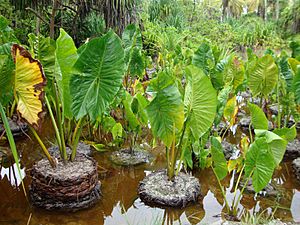
To complement the rather low consumption of carbohydrates in their diets, the I-Kiribati processed the sap and fruit of the abundant pandanus and coconut trees into different beverages and foods such as te karewe (fresh daily sap of the coconut tree) or te tuae (dried pandanus cake) and te kabubu (dried pandanus flour) from pandanus fruit pulp and te kamaimai (coconut sap syrup) from coconut sap.
After World War II, rice became a daily staple in most households, which is still the case today. The majority of seafood, fish in particular, is eaten sashimi-style with either coconut sap, soy sauce or vinegar-based dressings, often combined with chillies and onions.
Coconut crabs and mud crabs are traditionally given to breastfeeding mothers, with the belief that the meat stimulates the production of high-quality breast milk.
Sport
Kiribati has competed at the Commonwealth Games since 1998 and the Summer Olympics since 2004. It sent three competitors to its first Olympics, two sprinters and a weightlifter. Kiribati won its first ever Commonwealth Games medal at the 2014 Commonwealth Games when weightlifter David Katoatau won Gold in the 105 kg Group.
Football is the most popular sport. Kiribati Islands Football Federation (KIFF) is an associate member of the Oceania Football Confederation, but not of world-governing body FIFA. Instead, they are member of ConIFA. Kiribati National team has played ten matches, all of which it has lost, and all at the Pacific Games from 1979 to 2011. The Kiribati football stadium is Bairiki National Stadium, which has a capacity of 2,500.
The Betio Soccer Field is home to a number of local sporting teams.
See also
 In Spanish: Kiribati para niños
In Spanish: Kiribati para niños








